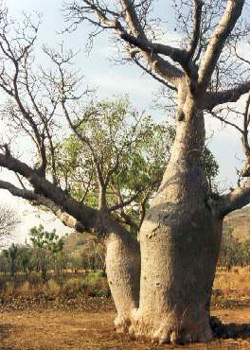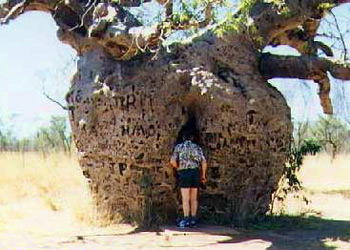
Getting to Know the Boab Tree
Marion Jarratt
Note: This article originally appeared in 'Brigge', the newsletter of the friends of Burrendong Arboretum. The Arboretum is located in the central west of New South Wales, near Wellington.
Visit the Burrendong Arboretum website
The botanical description for the Boab Tree (Adansonia gregori) is "Small to large tree; trunk usually very broad, often grotesque; branches small, light; leaves compound; flowers large, showy; fruits rounded or sausage-like." The common name is Bottle Tree or Boab.
| |
 |
| |
Adansonia gregorii: Boab
Photo: Aussie Outback Tours |
Did you know that:
- Depending on their size some trees can store up to 100,000 litres of water
- There is only one species endemic to Australia
- There are two instances in Western Australia where boab trees are reputed to have been used as overnight cells for Aboriginal prisoners being taken to Derby. Both are immense trees and it is said that 10 to 15 men could be accommodated. In fact one tree was fitted with an iron grate so prisoners could be locked inside.
Australia's boab trees are closely related to those of Madagascar and Africa and are one of eight species of trees in the same genus, Adansonia [named after French naturalist, Adanson].
Six species of boab occur in Madagascar but only one in Africa and one in Australia. This odd distribution pattern made botanists postulate that they may have originated in the ancient supercontinent of Gondwana before it broke up 60 million years ago.
Recent genetic studies indicate that the genus is much younger - appearing a mere 17 million years ago - probably in Madagascar. And how did they get to Australia? The seeds are far too large to be carried by birds. The accepted answer is that the giant seed pods sailed here, eventually washing up somewhere on the north west coast from where they have spread over much of northern Australia.
The huge trunk filled with soft fibrous wood enables the tree to store water in dry times and is a definite plus for life in tropical Australia. The boab was appreciated by the Aborigines who blended the sap with water to make a tasty drink and who ate the seeds and the pithy material surrounding them. They also used the woody fibres to make twine and nets.
(If you visit Burrendong Arboretum, see the Boab Tree on the right hand side as you drive into the lower car park.)
 |
A Boab prison tree
Photo: Aussie Outback Tours |
From 'Brigge', the newsletter of the Friends of Burrendong Arboretum Inc., January 2009.
Australian Plants online - 2009
Australian Native Plants Society (Australia)
|